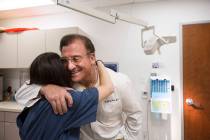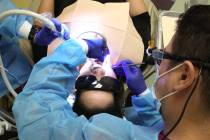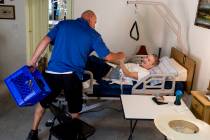Surviving cancer, inspired to help others
When I met Christine Wunderlin three years ago, her left arm had swelled to about twice the size of her right.
A few months earlier, the breast cancer patient had undergone a mastectomy in which the surgeon also removed lymph nodes from the underarm closest to the breast cancer. Lymph nodes are reliable predictors in determining whether the cancer has spread to other parts of the body.
As we talked in 2010, a therapist treated Wunderlin for lymphedema, a painful buildup or blockage of fluid in tissues that frequently occurs as a result of excising lymph nodes or using radiation on them. Lymph nodes are tiny glands needed to drain and regulate lymph, fluid containing blood cells that fight infection. The National Cancer Institute estimates it affects as many as 56 percent of women within two years of having breast cancer surgery.
“I could deal with my mastectomy easier than lymphedema,” Wunderlin, who runs a career counseling business in Las Vegas, said recently. “It affected how I dressed, looked, my confidence, what I did. I can camouflage my left side by using a prosthetic, but there’s no way to hide a swollen arm.”
Today, the 68-year-old Wunderlin, who went through expensive treatment for the condition, has her lymphedema under control with the help of a compression garment she must wear daily.
For most people, that would end their focused involvement with the condition. But Wunderlin couldn’t stop thinking about women who might not be able to afford treatment often not covered by insurance.
“What was appalling to me,” she said, “is that … health care professionals and … insurance companies just seem to dismiss lymphedema — having the attitude you should be glad you’re alive. … I decided to do something.”
She talked a friend, Cynthia Judge, who also has lymphedema, into co-hosting an Internet radio podcast, “Lymphedema Mavens,” that frequently has medical personnel and people with the condition as guests.
“We educate, inform, support and advocate for people with lymphedema,” Wunderlin said.
You can reach those programs by visiting www.thecityfm.com and scrolling to “Lymphedema Mavens.”
She frequently urges people to visit www.lymphedematreatmentact.org to learn about a proposed federal bill that would improve coverage for the diagnosis and treatment of lymphedema. Although it relates specifically to a change in Medicare law, private insurance policies generally follow Medicare’s lead.
“Right now,” she said, “many insurance companies in Nevada aren’t covering much, if any, of the treatment.”
According to a 2009 study on lymphedema in the Journal of Clinical Oncology, insurance companies have wide latitude in determining benefit levels for a condition that raises two-year postoperative costs by $8,000, including treatment for infections and depression. That study prompted Dr. Robert Smith, of the American Cancer Society, to observe: “It’s a terribly overlooked problem. Many … women have significant out-of-pocket expenses, and prolonged and chronic health problems as a result of it.”
Las Vegas breast cancer surgeon Dr. Josette Spotts stresses cancer specialists take lymphedema seriously, pointing out advances in research that allow surgeons today to take out just one underarm lymph node, the “sentinel node,” if it tests negative for cancer. Wunderlin noted that women who test positive undergo more extensive surgery and radiation therapy that more frequently leads to lymphedema.
When I saw Wunderlin in treatment — for two months, she had therapy at least three times a week at a cost of about $125 for each session — a therapist gently massaged Wunderlin’s upper torso, doing manually what her lymphatic system wasn’t, pushing fluid into the circulatory system and then out of the body. A pneumatic pump that she uses to massage her arm at home cost her $5,000.
Lymphedema compression garments can cost as much as $2,000 but the average is $400, Wunderlin said. Often two sets are needed so one can be washed. A different garment is worn at night.
Many Nevadans contact Wunderlin after listening to her podcast, with some complaining they can’t afford lymphedema treatment. She tries to find funding for them.
Untreated lymphedema, with its protein-rich fluid collecting under the skin, doctors say, is the perfect breeding ground for cellulitis, an aggressive infection requiring weeks of expensive hospitalization and costly antibiotics to treat. Sometimes it’s fatal.
“Breast cancer patients with lymphedema are the collateral damage done by breast cancer treatment,” Wunderlin said. “Are we going to allow some who are financially challenged to continue to suffer because they tried to get rid of a disease?”
Paul Harasim can be reached at pharasim@reviewjournal.com or 702-387-2908.

















